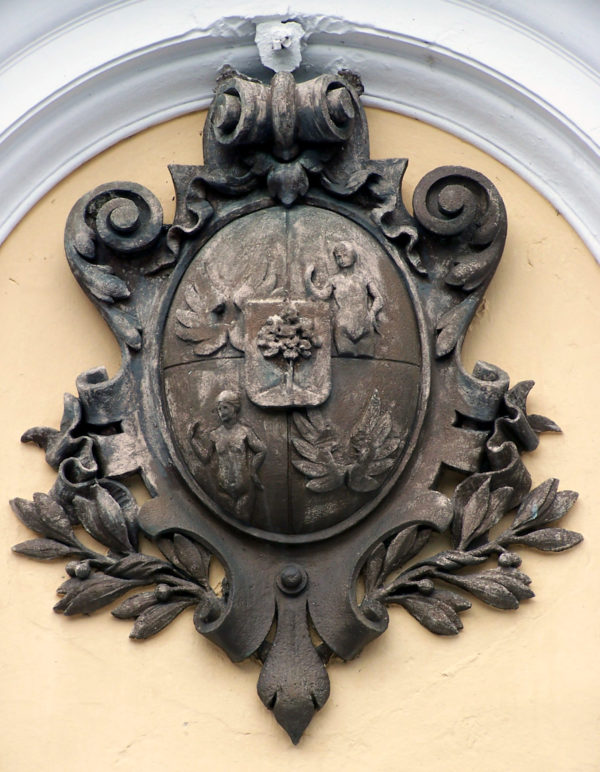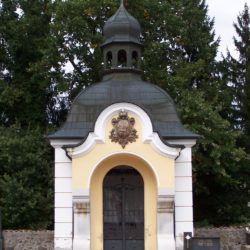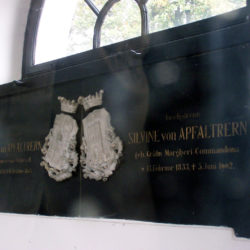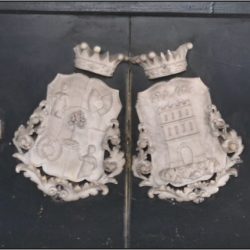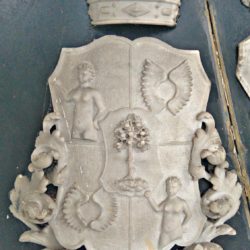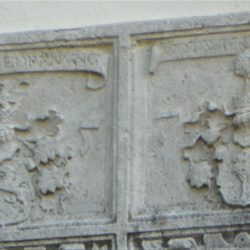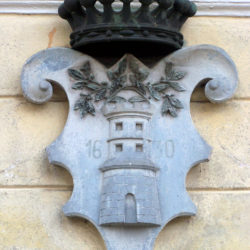
Coat of arms of the Apfaltrer family in Litija
LITIJA, CEMETERY
Location of the coat of arms: tomb
The Apfaltrers were one of the oldest noble families and had one of the longest continuities in Slovenia. Originally from Carinthia, they most likely came to Carniola in the second half of the thirteenth century in the service of the Spanheims and settled in newly built Roje Castle above Šmartno pri Litiji. They remained in Slovenia for the next seven centuries, until the outbreak of the Second World War.
The Apfaltrers owned Roje Castle until the end of the sixteenth century; however, according to Johann Weikhard von Valvasor, they abandoned it after it was struck by lightning twice and moved to lowland Grmače Castle. An Apfaltrer branch remained there until the castle was burned down in the Second World War. After the war, the Litija Collective Farm was built in its location.
Today, the only memory of the Barons Apfaltrer in Litija and its surroundings is their abandoned tomb in the Litija cemetery, which was used as a funeral chapel after the Second World War. Displaying a beautiful baronial coat of arms above its entrance, the tomb holds the remains of Rudolf Baron von Apfaltrer (1819–1893) and his wife Silvine, née Countess von Margheri-Commandona, from Otočec (1833–1902). Having died childless and with Rudolf’s brothers and their descendants buried elsewhere, they seem to be the only deceased laid to rest in the tomb. Further testifying to Baron Rudolf’s attachment to his native Carniola is his last will and testament, in which he urged his nephews as his sole heirs to never leave Carniola and to start learning Slovenian as soon as possible.
Despite their ancient origins placing them among the so-called pre-nobility, the Apfaltrers never surpassed the rank of barons, which was granted to them in 1672, and their new title with the predicate stating: “Baron Apfaltrer, Lord of Roje, Grmače, and Motnik.” Because the baronial diploma exclusively used the form Apfaltrer, it is not entirely clear why already in the eighteenth century and then especially in the nineteenth and twentieth centuries the family preferred to use the style Apfaltrern or even Apfalter von Apfaltern.
Together with the baronial rank, they were also granted an improvement in the coat of arms, which was expanded with the image of black wings and a nude black woman, whereas the original coat of arms featuring an apple tree and seven red apples was converted into the heart-shaped escutcheon. Despite strict rules governing heraldry, the Apfaltrers’ coat of arms is one of those that frequently broke them. Thus, the heart-shaped escutcheon is, for example, sometimes blue and sometimes green, the apples are depicted as either red or golden, and the position of the black woman often changes in the quartered escutcheon by sometimes being featured in the first and fourth fields and at other times in the second and third fields, with her pearl bracelet depicted as a golden ribbon on her upper arm.
Sources:
Kotar, Jernej: Apfaltrerji na Gamberku. Kronika 66, 2018, no. 2, pp. 197–212.
Smole, Majda: Kranjska plemiška rodbina Apfaltrerjev. Kronika, 18, 1970, pp. 24–27.
Stopar, Ivan: Grajske stavbe v osrednji Sloveniji. II. Dolenjska. Med Bogenšperkom in Mokricami (vol. 13). Ljubljana 2001, p. 56.
Litija, cemetery
Pokopališče Litija, Pokopališka pot, Litija, SlovenijaOther coats of arms of the Apfaltrer
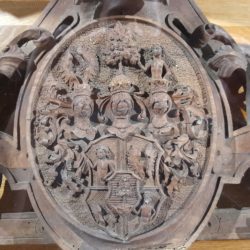
Coat of arms of the Apfaltrer family in Bogenšperk Castle
Šmartno pri Litiji
